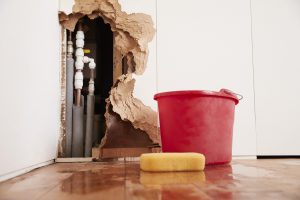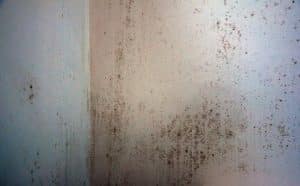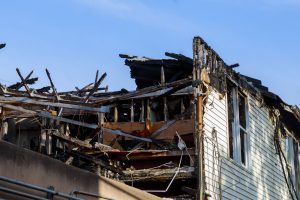Water Damage Restoration is better known as Water Mitigation. According to FEMA, Water Mitigation is the process of reducing the loss of property due to the impact of the disaster. Water Damage affects properties in a multitude of different situations. Ranging from the source of the leak, the location of the damage, or the quality of water that is leaking. Regardless of the situation, Water Damage is a serious situation that can cause a lot of damage if not handled properly. The most important thing is to react as quickly as possible.
Regardless of the situation, water damage is identified into categories and classes. The category of water describes the cleanliness of the water, while the class describes the amount and the severity of the damage caused. Water can be organized into 3 different categories. Cat 1 is water the comes from a clean source. This includes leaking faucets, supply lines, or a failed water heater. Category 2, also known as Grey Water, is water that has been contaminated in some way that can cause discomfort or illness if ingested. Grey water can be from a dishwasher or Washing machine overflow, water that has leaked from upstairs and has passed through building materials, or a toilet overflow of urine. Cat 3, nicknamed Black Water, is water that is grossly unsanitary that contains human/animal waste or other contaminates. Ingesting Black water can cause severe illness of death. Some examples of Black water include sewage back up, flood water, or standing water that has begun to support Microbial growth. No matter the category of water, the Water Damage should be handled immediately, because even a Category 1 can become a Cat 3 if not handle in a timely manner.
There are 4 different classes of water damage and these classes are separated by the amount of damage the water caused the property. Class 1 is the least amount of damage, and the easiest to deal with. Class 1 is when only part of a room/area is affected. Water mitigation is still needed, but minimal repairs are necessary. Class 2 is a little more damage than Class 1. Class 2 is when the water damage affects the entire room/area. Also, the moisture affects structural materials, and the water has wicked up the walls at least 12inches. Class 3 generally has the most damage, and most of the time is caused from the liquid coming down from the ceiling affecting the ceilings, walls, insulation, flooring, and sub-floors. It will also be classified as a Class 3 if the moisture has wicked up the walls over 24inches. Class 4 is the last one, and is also referred to as specialty drying situations. These situations when materials with lower permeance are affected. These materials include hardwood floors, plaster, concrete, and under tile. Getting rid of moisture from these materials need longer drying times and more specialized equipment such as drying mats or inject dry systems.
Most people go through their lives not thinking that they will ever need a restoration company, but the reality is that most people will experience water damage in their home at some point in their life time. We at JASD Restoration realize that your home is your safe place, and when something happens it can be overwhelming and hard to deal with.
The water mitigation process is normally foreign to those the first time they experience it, so below we have included a step-by-step guide to the process. We want you to feel comfortable, and make the process as easy as possible for you and your family.
Step 1: Contact Restoration Company Immediately
The most important step in the process is going to be your emergency contact. At JASD Restoration, our phone lines are open 24/7 365 to help you get your job started. When you call 772-334-8374 you will always talk to a certified technician.
During your preliminary call we will ask questions to assess the situation so we can understand to best help you and your property. These questions will help understand how many rooms are affected, and what equipment is needed to begin your job. We will schedule an appointment that fits your schedule, or come out immediately if it an emergency. We come out rain or shine, day or night.
Step 2: Inspection & Assessment
The next step of water mitigation is one of our IICRC Certified technicians arriving on the scene. IICRC is the governing body that sets the standards for the restoration industry. We inspect all the damaged areas, assess the situation, and come up with a specific plan to fix the issue. This is an important step so we as the restorers and the customer can understand exactly what’s going on and what the plan is moving forward.
We always want the customer to be informed and comfortable, which is why we explain exactly how much damage there is, and what the plan is to address the damage. Also, always feel free to ask questions. Our number 1 goal besides fixing your home is to take care of you.
Step 3: Water Extraction & Mitigation
After our technicians have inspected the damage and formulated a plan, we will begin to execute the plan to eliminate the remaining moisture from your home. The first thing we do is extract any standing water or soaked flooring using Sub Pumps or water proof vacuums based on the severity of the water intrusion. This equipment can suck hundreds of gallons rather quickly which helps to limit further damage to your home. We will also remove any materials that cannot be salvaged. Some of these materials included drywall, floating floors, carpet pad, insulation, and baseboard.
Step 4: Drying & Sanitizing
After we extract most of the water from the home, and remove the unsalvageable materials we begin the drying process. After we removed the affected materials and the standing water it is important to dry out the remaining structure, because moisture is still very present. Also, after there is a water loss mold becomes a huge concern, especially in Florida.
Due to Florida’s high temperatures and humidity Mold can begin to grow very quickly throughout the affected areas. Mold only needs 2 things to survive and that is moisture and organic materials to eat. These organic materials include carpet, drywall, leather, wood, and paper products.
To dry the rest of the home we use industrial strength Dehumidifiers and Fans. The dehumidifiers begin to suck the moisture out of the air, and once the area is at a target humidity it will begin to pull the rest of the moisture from the affected structure. The fans are to heat up the affected materials to aide in the evaporation of moisture so that the dehumidifiers can suck the moisture out. The amount of equipment is based on the class of water and the size of each affected room.
Step 5: Sanitizing the Room
We pride ourselves on our cleanliness and professionalism. After the affected rooms are completely dry, we begin the cleaning and sanitizing process. After we remove all of our equipment, we do a thorough vacuuming and mopping on our way out.
Our technicians also sanitize the affected areas with antimicrobial chemicals to prevent any mold from beginning to grow. The antimicrobial we use is plant based, and is safe for your family along with any fur babies that you might have. Our antimicrobial is also food surface safe.
If needed, we will also use air scrubbers and fogging equipment to eliminate any odors that might result from stagnant water.
Step 6: Restoration
The Final step of the process is the Restoration of your home. Our goal is to return your home back to normal, or even better in some cases. At JASD Restoration we are also a full-service General Contractor and can handle small or major repairs. Small repairs normally include painting, baseboards, cabinetry, and countertops. Major repairs are normally when there is a big loss that affects most of the home.
An example of major repairs is if there is a leak upstairs and downstairs is taken down to the studs. In this instance we would fix the electrical, replace the drywall and insulation, retexture and paint the walls and ceilings, and replace any damaged materials such as flooring, cabinets, and countertops.
Also, this step is a great opportunity to do any upgrades that you and your family have been thinking about. Our goal is to leave the customer with a home that they can feel happy and safe in.



